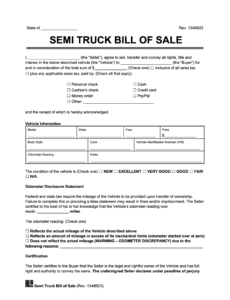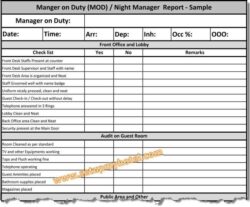Buying or selling a semi truck is a big deal, much more complex than a typical car sale due to the size, value, and commercial implications. Whether you’re an independent owner-operator looking to upgrade, a fleet manager expanding your operations, or simply divesting an asset, ensuring a smooth and legally sound transaction is paramount. This isn’t just about handing over keys and receiving cash; it’s about formalizing the transfer of a substantial asset with significant legal and financial responsibilities attached.
That’s where a properly drafted bill of sale comes into play. It acts as the cornerstone of your transaction, providing clear evidence of the sale and protecting both the buyer and the seller. Without this crucial document, you could find yourself in a tricky legal bind down the road, facing disputes over ownership, liability, or the condition of the vehicle. Understanding what makes an effective bill of sale, and having a reliable semi truck bill of sale template at your disposal, can save you a lot of headaches and ensure peace of mind for everyone involved.
What is a Semi Truck Bill of Sale and Why Do You Need One?
A semi truck bill of sale is a legal document that formally records the transfer of ownership of a heavy-duty commercial truck from a seller to a buyer. It’s essentially a receipt for the transaction, but much more comprehensive, detailing all the critical information about the sale. Think of it as undeniable proof that the vehicle has changed hands, specifying the terms and conditions under which this transfer occurred. This document is recognized by legal entities and government agencies, making it an indispensable part of any semi truck transaction.

For the seller, having a signed bill of sale is crucial for proving that they no longer own the semi truck. This releases them from future liability related to the vehicle, such as accidents, tickets, or registration issues that might arise after the sale. It also serves as official proof of the sale date, which is vital for tax purposes and for canceling insurance policies associated with the truck. Without it, you could potentially be held accountable for actions related to a truck you no longer possess.
On the buyer’s side, the bill of sale is your primary proof of ownership. You’ll need it to register the semi truck with the Department of Motor Vehicles (DMV) or equivalent state agency, apply for new license plates, and obtain commercial vehicle insurance. Lenders also typically require a bill of sale as part of the loan application process for commercial vehicles. It provides a detailed record of what you purchased, helping to prevent future disputes over the vehicle’s condition or sale price.
Beyond the immediate administrative needs, a detailed bill of sale protects both parties by documenting the agreed-upon terms, the vehicle’s condition at the time of sale, and any specific disclosures made. It clearly outlines the “as-is” condition if applicable, or any warranties agreed upon. In the unfortunate event of a dispute, this document becomes the most critical piece of evidence to resolve the issue legally and efficiently.
Key Information a Semi Truck Bill of Sale Should Contain
- Full names and contact information (addresses, phone numbers) for both the buyer and the seller.
- A detailed description of the semi truck, including make, model, year, Vehicle Identification Number (VIN), and odometer reading.
- The agreed-upon purchase price and the method of payment.
- Date of sale.
- A statement of transfer of ownership.
- Signatures of both the buyer and the seller, and often a witness.
- Any specific conditions or disclosures, such as an “as-is” statement or details about existing liens.
Essential Elements of a Comprehensive Semi Truck Bill of Sale Template
When preparing or utilizing a semi truck bill of sale template, attention to detail is paramount. A comprehensive template ensures that all necessary legal and transactional information is included, leaving no room for ambiguity or future misunderstandings. It’s about creating a clear, concise, and legally binding record that protects everyone involved in the transfer of a valuable commercial asset. Getting this document right from the outset can save significant time, effort, and potential legal fees down the line.
First and foremost, the template should prominently feature the full legal names and current addresses of both the seller and the buyer. This seems straightforward, but ensuring accuracy here is critical for identification purposes. Include phone numbers and email addresses as well, as these can be invaluable for any follow-up communications. If either party is a business entity, the full legal business name and official address, along with the name and title of the authorized signatory, must be clearly stated. This level of detail establishes who is legally entering into the agreement.
Next, the semi truck itself needs to be meticulously described. This section should go beyond just the make and model. It must include the exact year of manufacture, the manufacturer (e.g., Freightliner, Peterbilt, Kenworth), and the specific model. Crucially, the Vehicle Identification Number (VIN) must be listed accurately, as this is the unique identifier for the truck. The current odometer reading at the time of sale is also vital, and many jurisdictions require an odometer disclosure statement to prevent odometer fraud. Details about the engine, transmission, and even specific equipment like sleeper cabs or fifth wheels can add further clarity.
The financial terms of the sale form another cornerstone of the bill of sale. Clearly state the agreed-upon purchase price in both numerical and written form to prevent any misinterpretation. Detail the method of payment, whether it’s a lump sum, a down payment with installments, or a trade-in. If there’s a deposit involved, specify the amount and how it will be applied to the total price. This section ensures there’s no confusion regarding the financial transaction, which is often the most common area for disputes if not clearly documented.
Finally, the signatures and date are what legalize the document. Both the buyer and the seller must sign and date the bill of sale. It’s highly recommended, and in some states, required, to have the signatures witnessed by a neutral third party, or even notarized. Notarization adds an extra layer of authenticity, confirming that the signatures are legitimate. Each party should receive an original copy of the signed document for their records. This ensures that everyone has verifiable proof of the transaction, ready to be presented for registration, insurance, or any other official purpose.
Having a robust bill of sale means you’ve taken the necessary steps to secure your investment and ensure a transparent, legally compliant transfer of ownership. It’s a simple document that carries immense weight, providing a solid foundation for your new venture or a clean break from your previous ownership responsibilities.



